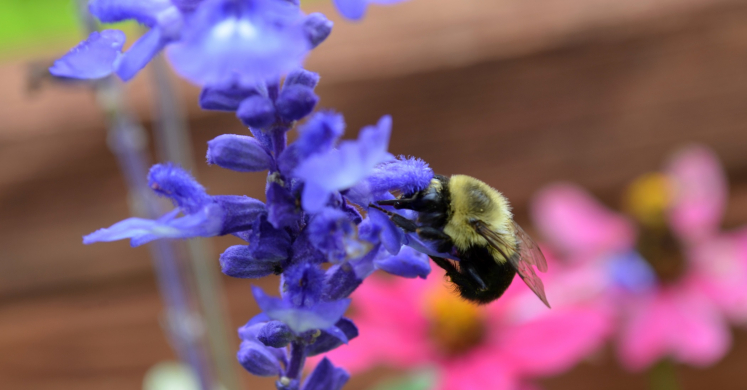Blog

#bioPGH Blog: The Humble Bumble Name Game
 A resource of Biophilia: Pittsburgh, #bioPGH is a weekly blog and social media series that aims to encourage both children and adults to reconnect with nature and enjoy what each of our distinctive seasons has to offer.
A resource of Biophilia: Pittsburgh, #bioPGH is a weekly blog and social media series that aims to encourage both children and adults to reconnect with nature and enjoy what each of our distinctive seasons has to offer.
Earlier this week, I was using Google Scholar to search for some wildflower information, but my curiosity was piqued by an article title from 1887: “How humblebees extract nectar from Mertensia virginica, DC.” A humblebee? What’s a humblebee? I wondered, assuming it was a species I’d never heard of — there are over 4000 species of bees in the US alone, so that wouldn’t be a stretch! With a bit of digging, though, it seemed that was the common name for bumblebees until less than a century ago. This led me to wonder, why the original name, and when exactly did the name switch over? Though there isn’t a clear answer on the etymology (honest spoiler alert), the research dive was another reminder of many excellent resources are available to us online. You just need a little determination and a healthy dose of internet skepticism. Come follow the research journey!
When I began my humble bumblebee dive, the first source I found was in article in the UK source The Guardian, which noted that prior to the common use of “bumble bee,” “humble bee” was the preferred common name by Charles Darwin (1809-1882) and his contemporaries throughout the mid-nineteenth century. Indeed, the Darwin Correspondence Project at the University of Cambridge has over 100 letters or articles written by or to Darwin that use the term “humble bee” or “humblebee” while only 20 reference a “bumble bee” or “bumblebee” (and notably, many of these documents clarify the insect in question by also including the name “humble bee.”)
It’s worth noting that both bumble bee and humble bee were in use prior to Darwin’s prime career era, though. For example, this book of insects in “British America” notes both humble bee and bumble bee as the common names of the bees of the Bombus genus. Similarly, page 79 of the 1855 Transactions of the Philological Society described “humble bee” as having been derived from the term “bomble bee,” which was a reference to bombilus, or the Latin name for bumble bee genus Bombus — meaning to buzz or hum. in 1885, Longman’s Magazine used humble bee as the common name, but the writer noted that “humble bee” was derived from the “true” common name, bumble bee — which suggests the original name change was from bumble bee to humble bee, and somehow back again. Curiously, an 1877 British book on etymology refers to “bumble bee” as the Scottish version of humble bee, though it offers both names as an example of words meant to imitate their reference —this case, the buzzing or humming of a large bee.
When I set my Google Scholar search to different time frames in the twentieth century, the decline in use of the word “humble bee” was noticeable over the first forty years, but not absolute. The term remained in some pieces of writing in some cases as a nostalgic reference, though it appeared in scientific literature at least as late as the 1950s (e.g. here and here).
In the end, there didn’t seem to be a clear answer as to why the change in terminology, but language is fascinating like that. It shifts and evolves just like populations and species. Since we have already referenced Darwin today, it seems appropriate to come full circle and nod to an inevitable concept of life: there is change over time.
Connecting to the Outdoors Tip: If you’re out in the wild world and have a burning curiosity about this species or that natural process, Google Scholar is a great way to dig through the latest scientific findings about different topics. But as we noted today, it’s also a way to connect to historical work on a topic. Can we just take a moment to enjoy this writing style from a 1912 article in the journal Nature:
“On February 11, a mild and sunny day, my bees were working busily on Eranthis hiemalis, the winter aconite, and by watching them I was able to verify my opinion, published in The British Bee journal of December 14, 1911, that the pollen is collected by being scraped into the fissure between the tibia and metatarsus, and is compressed and forced out into the “corbicula,” or pollen-basket, on the outside of the tibia by the closing of the fissure, a conclusion suggested by the examination of the hind leg of a queen humble-bee.”
Resources
History of the Humble-bee in New Zealand, Isaac Hopkins, 1914, government report

